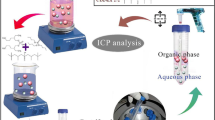Abstract
Methodologies comprising usage of innocuous reagents, lower overall chemical inventory and simplification of process scheme for plutonium recovery from assorted matrices, solid as well as liquid, are key to establishing sustainability of the nuclear fuel cycle. The present study demonstrates, for the first-time, plutonium leaching from different refractory matrices: oxide, mixed oxide as well as simulated cellulosic waste using the benign halide anion free choline citrate - urea (1 : 2 mole ratio) based eutectic solvent (referred to as CU). This mineral acid and hydrofluoric acid-free, non-aqueous route of plutonium recovery with controlled infra-red heating yielded ≥93% efficiency. CU was diluted with biodegradable, less viscous propylene glycol (referred to as PG), which was chosen as the non-aqueous polar phase for facile solid phase extraction (SPE), which is a green alternative to liquid-liquid extraction owing to process simplification and solvent inventory reduction. Exclusive stabilization of tetravalent plutonium in the novel media, confirmed by ultraviolet-visible spectrophotometry and electrochemical methods, led to process simplification, eliminating any pre-extraction requirement for oxidation state adjustment. Extractant, di-2-ethyl hexyl phosphoric acid encapsulated polyether sulfone beads, prepared by phase inversion method, were employed for efficient SPE of plutonium (Distribution co-efficient, kD=950±6). Selectivity of non-aqueous SPE was found to be Pu(IV)≫UO 2+2 >Am(III) vis-à-vis aqueous acid medium.
Similar content being viewed by others
References
C. P. S. Bourg, N. Ouvrier, N. Combernoux, C. Rostaing and J. Bruno, Energy, 69, 199 (2014).
H. N. Sethna, India’s atomic energy programme: Past and future, IAEA Bulletin (2021).
H. S. Kamath, Energy Procedia, 7, 110 (2011).
Chemical characterization of Nuclear Fuels. IANCAS Bulletin VII, 3 (2008).
C. Musikas, W. Schulz, in Principles and practices of solvent extraction, J. Rydberg, C. Musikas, G. R. Choppin Eds., Marcel Dekker Publications, New York, 413 (1992).
J. L. Ryan and E. J. Wheelwright, Ind. Eng. Chem. Res., 51, 60 (1959).
K. Binnemans and P. T. Jones, J. Sustain. Metall., 3, 570 (2017).
N. K. Batchu, T. V. Hoogerstraete, D. Banerjee and K. Binnemans, RSC Adv., 7, 45351 (2017).
B. Dewulf, N. K. Batchu and K. Binnemans, ACS Sustain. Chem. Eng., 8, 19032 (2020).
N. K. Batchu, L. Zheng and K. Binnemans, Sep. Purif. Technol., 255, 117711 (2021).
Z. Li, B. Dewulf and K. Binnemans, Ind. Eng. Chem. Res., 60, 17285 (2021).
S. Usuda, Studies on Rapid Ion-Exchange Separation of The Transplutonium Elements with Mineral Acid-Methanol Mixed Media, JAERI March 1315 (1989).
A. A. Abbott, G. Capper, D. L. Davies, R. K. Rasheed and V. Tambyrajah, Chem. Commun., 19, 2010 (2001).
C. J. Clarke, W. C. Tu, O. Levers, A. Bröhl and J. P. Hallett, Chem. Rev., 118, 747 (2018).
G. Zante and M. Boltoeva, Sustain. Chem., 1, 238 (2020).
Y. Ohashi, N. Asanuma, M. Harada, Y. Tanaka and Y. Ikeda, J. Radioanal. Nucl. Chem., 309, 627 (2016).
S. Riano, M. Petranikova, B. Onghena, T. V. Hoogerstraete, D. Banerjee, M. R. S. J. Foreman, C. Ekberg and K. Binnemans, RSC Adv., 7, 32100 (2017).
R. Gupta, J. Gamare, S. K. Gupta and S. S. Kumar, J. Mol. Struct., 1215, 128266 (2020).
A. Rao and A. Srivastava, Sep. Purif. Technol., 257, 117950 (2021).
A. Srivastava, R. M. Rao Dumpala, P. Sahu, A. K. Yadav, N. Rawat, S.K. Musharaf Ali, M. Sahu, N. Pathak and A. Sengupta, ACS Sust. Chem. Eng., 9, 7846 (2021).
R. West, M. Banton, J. Hu and H. Klapacz, Rev. Environ. Contam. Toxicol., 232, 107 (2014).
S. S. Kumar, A. Rao, K. K. Yadav, R. K. Lenka, D. K. Singh and B. S. Tomar, J. Radioanal. Nucl. Chem., 324, 375 (2020).
J. L. Drummond and R. A. Grant, Talanta, 13, 477 (1966).
K. K. Yadav, D. K. Singh, M. Anitha, L. Varshaney and H. Singh, Sep. Purif. Technol., 118, 350 (2013).
K. K. Yadav, K. Dasgupta, D. K. Singh, L. Varshaney and H. Singh, J. Chromatogr. A, 1384, 37 (2015).
K. Chander, B. N. Patil, J. V. Kamat, N. B. Khedekar, R. B. Manolkar and S. G. Marathe, Nucl. Technol., 78, 69 (1987).
M. Marchel, H. Cieśliński and G. Boczkaj, Ind. Eng. Chem. Res., 61(30), 11288 (2022).
D. L. Clark, S. S. Hecker, G. D. Jarvinen and M. P. Neu, Plutonium, chapter 7, 813, in The chemistry of the actinide and transactinide element, L. R. Morss, N. M. Edelstein, J. Fuger Eds., Springer Publications (2010).
A. J. Francis, J. D. Cleveland and J. B. Gillow, Radiochim. Acta, 94, 731 (2005).
A. Ikeda, C. Hennig, S. Tsushima, K. Takao, Y. Ikeda, A. C. Scheinost and G. Bernhard, Inorg. Chem., 46, 4212 (2007).
A. Warshawsky, Trans. Inst. Mining Metall. C., 83, 101 (1974).
X. C. Gong, G. S. Luo, W. W. Yang and F. Y. Wu, Sep. Purif. Technol., 48, 235 (2006).
W. W. Schulz, D2EHPA Extraction recovery: Chemistry of neptunium and Plutonium from Purex process sludge, Pacific Noth West Laboratory, Richland, Washington, BNWL 583 (1968).
C. Sella, A. Becis, G. Cote and D. Bauer, Solv. Extr. Ion Exch., 13(4), 715 (1995).
Acknowledgements
SSK, AR and AS are grateful to Dr. P.K. Mohapatra, Head, RCD and Dr. Neetika Rawat, RCD for their support and encouragement during the course of this work. Authors also acknowledge Dr. D. K. Singh, MP&CED for facilitating the preparation of PES beads.
Author information
Authors and Affiliations
Corresponding author
Ethics declarations
Authors have no conflict of interest to declare.
Rights and permissions
About this article
Cite this article
Kumar, S.S., Rao, A., Srivastava, A. et al. Experimental strategy for acid-free plutonium recovery from assorted matrices: Non-aqueous leaching followed by selective solid phase extraction. Korean J. Chem. Eng. 40, 2716–2723 (2023). https://doi.org/10.1007/s11814-023-1482-3
Received:
Revised:
Accepted:
Published:
Issue Date:
DOI: https://doi.org/10.1007/s11814-023-1482-3




